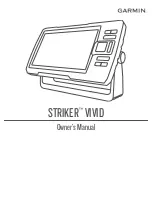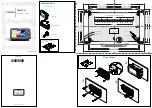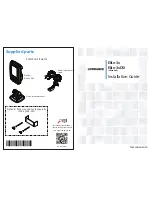
6
5. Set the gimbal bracket aside and drill the four mounting screw holes using a
5/32" (4.0 mm) drill bit.
6a. If the cables must pass through a hole directly beneath the mounting bracket,
mark and drill an additional 1" (25 mm) hole centered between the four
mounting holes. Route the cables through the grommet, then press the grom-
met in place around the cables and into the 1" (25 mm) hole. Pass the cables out
of the back of the mounting bracket. Using needle-nose pliers, break out the
tabs on the rear of the mounting base. You will need to break out the cable tabs
for the number of cables you want to run to your control head.
6b. If the cables cannot be routed directly beneath the mounting bracket, mark and
drill a 1" (25 mm) hole that will allow you to run the cables close to the bracket.
Pass the cables through the 1" (25 mm) hole, routing the cables through the
grommet and pressing the grommet into place. Place the hole cover over the
mounting surface hole, then use it to mark the position of the two mounting
screws. Remove the hole cover, drill the two mounting holes using a 9/64"
(3.5 mm) bit, fill them with marine-grade silicone, then replace the hole cover
and insert the #8 Phillips countersink wood screws.
Hand-tighten only
.
NOTE
: Be sure that the cables pass through the slots on the hole cover or gimbal bracket
break out tabs and there is enough cable slack to allow for the control head to pivot through
its full tilt range. Extra cable slack will also help when connecting/disconnecting the cables.
7. Place the mounting bracket on the mounting surface aligned with the drilled
holes and fill the mounting holes with marine grade silicone. Insert the four #10
Slotted-Hex wood screws into the mounting holes.
Hand-tighten only.
8.5"
5"
3.6"
1.25"
Mounting Screws
1
Washer
2
Gimbal Mounting Bracket
3
1
3
2
98x_Manual_531376-1_A.qxd 2/23/2005 11:39 AM Page 12

![Preview for 1 page of Humminbird ] 981 Installation & Operation Manual](http://thumbs.mh-extra.com/thumbs/humminbird/981/981_installation-and-operation-manual_2183846-01.webp)
![Preview for 2 page of Humminbird ] 981 Installation & Operation Manual](http://thumbs.mh-extra.com/thumbs/humminbird/981/981_installation-and-operation-manual_2183846-02.webp)
![Preview for 3 page of Humminbird ] 981 Installation & Operation Manual](http://thumbs.mh-extra.com/thumbs/humminbird/981/981_installation-and-operation-manual_2183846-03.webp)
![Preview for 4 page of Humminbird ] 981 Installation & Operation Manual](http://thumbs.mh-extra.com/thumbs/humminbird/981/981_installation-and-operation-manual_2183846-04.webp)
![Preview for 5 page of Humminbird ] 981 Installation & Operation Manual](http://thumbs.mh-extra.com/thumbs/humminbird/981/981_installation-and-operation-manual_2183846-05.webp)
![Preview for 6 page of Humminbird ] 981 Installation & Operation Manual](http://thumbs.mh-extra.com/thumbs/humminbird/981/981_installation-and-operation-manual_2183846-06.webp)
![Preview for 7 page of Humminbird ] 981 Installation & Operation Manual](http://thumbs.mh-extra.com/thumbs/humminbird/981/981_installation-and-operation-manual_2183846-07.webp)
![Preview for 8 page of Humminbird ] 981 Installation & Operation Manual](http://thumbs.mh-extra.com/thumbs/humminbird/981/981_installation-and-operation-manual_2183846-08.webp)
![Preview for 9 page of Humminbird ] 981 Installation & Operation Manual](http://thumbs.mh-extra.com/thumbs/humminbird/981/981_installation-and-operation-manual_2183846-09.webp)
![Preview for 10 page of Humminbird ] 981 Installation & Operation Manual](http://thumbs.mh-extra.com/thumbs/humminbird/981/981_installation-and-operation-manual_2183846-10.webp)
![Preview for 11 page of Humminbird ] 981 Installation & Operation Manual](http://thumbs.mh-extra.com/thumbs/humminbird/981/981_installation-and-operation-manual_2183846-11.webp)
![Preview for 12 page of Humminbird ] 981 Installation & Operation Manual](http://thumbs.mh-extra.com/thumbs/humminbird/981/981_installation-and-operation-manual_2183846-12.webp)
![Preview for 13 page of Humminbird ] 981 Installation & Operation Manual](http://thumbs.mh-extra.com/thumbs/humminbird/981/981_installation-and-operation-manual_2183846-13.webp)
![Preview for 14 page of Humminbird ] 981 Installation & Operation Manual](http://thumbs.mh-extra.com/thumbs/humminbird/981/981_installation-and-operation-manual_2183846-14.webp)
![Preview for 15 page of Humminbird ] 981 Installation & Operation Manual](http://thumbs.mh-extra.com/thumbs/humminbird/981/981_installation-and-operation-manual_2183846-15.webp)
![Preview for 16 page of Humminbird ] 981 Installation & Operation Manual](http://thumbs.mh-extra.com/thumbs/humminbird/981/981_installation-and-operation-manual_2183846-16.webp)
![Preview for 17 page of Humminbird ] 981 Installation & Operation Manual](http://thumbs.mh-extra.com/thumbs/humminbird/981/981_installation-and-operation-manual_2183846-17.webp)
![Preview for 18 page of Humminbird ] 981 Installation & Operation Manual](http://thumbs.mh-extra.com/thumbs/humminbird/981/981_installation-and-operation-manual_2183846-18.webp)
![Preview for 19 page of Humminbird ] 981 Installation & Operation Manual](http://thumbs.mh-extra.com/thumbs/humminbird/981/981_installation-and-operation-manual_2183846-19.webp)
![Preview for 20 page of Humminbird ] 981 Installation & Operation Manual](http://thumbs.mh-extra.com/thumbs/humminbird/981/981_installation-and-operation-manual_2183846-20.webp)
![Preview for 21 page of Humminbird ] 981 Installation & Operation Manual](http://thumbs.mh-extra.com/thumbs/humminbird/981/981_installation-and-operation-manual_2183846-21.webp)
![Preview for 22 page of Humminbird ] 981 Installation & Operation Manual](http://thumbs.mh-extra.com/thumbs/humminbird/981/981_installation-and-operation-manual_2183846-22.webp)
![Preview for 23 page of Humminbird ] 981 Installation & Operation Manual](http://thumbs.mh-extra.com/thumbs/humminbird/981/981_installation-and-operation-manual_2183846-23.webp)
![Preview for 24 page of Humminbird ] 981 Installation & Operation Manual](http://thumbs.mh-extra.com/thumbs/humminbird/981/981_installation-and-operation-manual_2183846-24.webp)
![Preview for 25 page of Humminbird ] 981 Installation & Operation Manual](http://thumbs.mh-extra.com/thumbs/humminbird/981/981_installation-and-operation-manual_2183846-25.webp)
![Preview for 26 page of Humminbird ] 981 Installation & Operation Manual](http://thumbs.mh-extra.com/thumbs/humminbird/981/981_installation-and-operation-manual_2183846-26.webp)
![Preview for 27 page of Humminbird ] 981 Installation & Operation Manual](http://thumbs.mh-extra.com/thumbs/humminbird/981/981_installation-and-operation-manual_2183846-27.webp)



